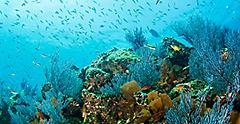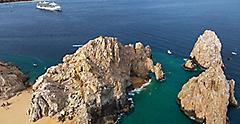By Chantae Reden | Published on April 14, 2023
At first glance, it might seem like Baja California is inhabited mainly by giant cardón cacti and surrounded by nothing but a deep blue sea. Dramatic coastal cliffs cede to sandy beaches and turquoise bays, with craggy islets in the distance. But once you look closer, you'll find a region teeming with life across land, sea and sky. Here's where to discover Baja California wildlife in its natural habitat, whether that's coastal cliffs and coves, coral reefs or pristine national parks.
According to UNESCO World Heritage Foundation, Baja California is home to nearly 40% of the world's marine mammal species and nearly 900 species of fish. The region's 700 species of plants provide a home to myriad mammals, reptiles and birds. Pack your binoculars, because a Mexico vacation to this wild peninsula is a nature lover's delight.
Witness An Incredible Whale Migration
The waters off Baja California during a visit are seen as a haven for the ocean's giants, like humpback whales, gray whales and blue whales, along with toothier predators like sperm whales and orca whales. Every year from December to April, humpback whales migrate from the freezing waters of the arctic circle to the warm waters of the Baja peninsula to mate and give birth.
Venture on a whale-watching tour to witness humpback whales leap out of the water and slap their fins against the surface. At the start of the season, it's common to spot strong bulls competing for female attention and hear the haunting songs of male whales singing underwater. Later in the season, juvenile whales frequent the waters, often cruising curiously near whale-watching vessels to get a closer look. Newborn whale calves stay beside their mothers, and you might see confident calves practicing their first breaches. Gray whales follow a similar migration route to humpback whales and are often seen from the shoreline of the Baja peninsula.
Cabo San Lucas and Ensenada are ideal hubs for whale-watching excursions, with tours running regularly from both ports. Tour operators like Cabo Nature in Cabo San Lucas have naturalist guides onboard to highlight whale behavior. From Ensenada, hop onboard a Sergio's Fishing whale-watching tour to see whales from Baja California's northern coast.
Spot Birds Both Big And Small
You don't have to be an expert birder to admire the feathered friends of Baja. The peninsula is home to multiple species that live nowhere else in the world and is a major stop for migrating seabirds. With such a large stretch of undeveloped coastline hosting lagoons and estuaries, the region is a haven for birdlife. Peek into wildflowers to admire the bright green and red plumage of the Xantus's hummingbird, endemic to Baja California, or the magenta shimmer of Costa's hummingbird. Gray thrashers, pygmy owls, Harris's hawks, cactus wrens, turkey vultures, and California quail all take refuge in the desert scrublands.
Scuba Dive Or Snorkel With Hundreds Of Mobula Rays
I squealed through the scuba diving regulator in my mouth the first time I saw a Mobula ray glide by. A few seconds later, I saw another. Then another. From the corner of my eye, the water darkened like a storm cloud. When I turned towards it, I was met with a school of hundreds of Mobula rays swimming above me in a synchronized aggregation. My dive guide and I held our position. Soon, we were surrounded by a vortex of dark gray and white rays swirling around us.
The sea surrounding Baja California Sur is an underwater world home to hundreds, sometimes thousands, of Mobula rays. These harmless rays are also called Munk's devil rays thanks to their protruding frontal lobes that resemble horns. The rays off Baja California are the smallest of the Mobula ray species, but what they lack in size, they make up for in acrobatics. The rays are often seen leaping out of the water, somersaulting and jumping in physics-defying flights. Underwater, prepare to be mesmerized by their grace as they glide and twirl weightlessly through the blue. They're undoubtedly one of the most unique Mexican animals to see.
The best time to scuba dive with Mobula rays is from mid-April to July and from November to January, when currents enrich the waters with plankton that makes for a smorgasbord of good eating for the filter-feeding rays. Baja Expeditions offers half-day snorkel and sightseeing tours from Los Cabos and La Paz. Scuba divers can blow bubbles with the rays with Dive Cabo from Cabo San Lucas.
Sunbathe With Sea Lions
One of the best things to do in Baja California is to find a beach and simply relax. The sea lions of the Baja peninsula have mastered this skill, setting an example on how to have an idyllic Mexico vacation. On the rocky outcrops of Baja's shoreline, like Land's End off Cabo San Lucas, you'll spot sea lions lounging under the warmth of the sun. Paddle a kayak along the coastline, or take a boat tour for prime views of these intelligent pinnipeds. These sea lions are often seen playing, bickering and bumping each other off a coveted ledge. They're not so different from us, after all!
Kayak On A Sea Safari
Baja California spans 760 miles north to south and is surrounded by water. Seascapes range from giant kelp forests to coral reefs, depending on the part of Baja California you're exploring. Paddle through the Cabo Pulmo Marine Park on a sea safari to spot loggerhead and leatherback sea turtles, sea lions, rays, dolphins and birds from the comforts of your kayak. Pack a set of snorkel gear to get a closer look at the reef bommies that catch your eye from above. Tours tend to be led by guides with a knack for spotting sea life. It's also possible to rent a kayak or paddleboard and head out on a DIY adventure if you'd rather do the wildlife spotting by yourself.
Meet Baja California's Inland Residents
Exactly what animals live in Mexico? Mexican bobcats, kit foxes, spiny-tailed iguanas, rock lizards, jackrabbits and multiple bat species also call the varied terrain of Baja California home. Baja California has hefty credentials when it comes to its abundance of marine life, though there are plenty of creatures worth admiring on terra firma, too. The peninsula landscape changes from the snow-capped peaks at Sierra de San Pedro Mártir to stretches of sun-soaked desert of Cabo Pulmo National Park. If you tread quietly, you might spot rare and unique animals like the pronghorn, a mammal that looks like an antelope — yet are actually a part of the Antilocapridae family — and runs nearly as fast as a cheetah.
Hiking through Fox Canyon near Cabo San Lucas is one of the best things to do in Baja California for wildlife lovers. Tour operators like High Tide Los Cabos will send a naturalist as your guide to point out the plants, insects and timid critters who might be lurking in the brush. Waterfalls with swimming holes await along the trail, offering a prime place to relax and wait for creatures to come close.
Over on Baja California's northern end, Ensenada is also an ideal starting point for exploring inland. Look closely at the treetops as you zip line over the canopy at Las Canadas adventure park. Or, trek over the fairy tale rock formations at El Salto Canyon and get misted by the giant waterfall in its interior. Birds, small mammals and bats have all found a place for themselves within the canyon.
Snorkel With Whale Sharks
Get Royal Deals, Sign Up Today

Getting There
Explore Our Most Affordable Itineraries
Ready to see these animals for yourself? Discover Baja California's natural habitats on a Royal Caribbean West Coast cruise.


















